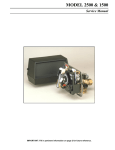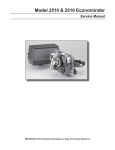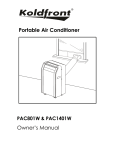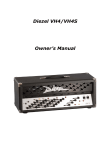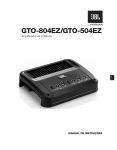Download Radiogram 2011-3
Transcript
HLARA RADIOGRAM 2011-3 The President S A Publication of the Heartland Antique Radio Association, Inc. As President of the Heartland Antique Radio Association for the past 3 years, I wish to express my heartfelt thanks to the officers, directors, and members of this fine organization. We have accomplished much together in these years that passed too quickly. Together, we hosted three outstanding Summer Sizzler shows per year with unprecedented member support. Sister club member participants cite our shows as among the best for organization, member support, and variety of radios. We relocated our weekly meetings to a better facility at the Hardesty Regional Library after being forced to move from our original meeting location. This move has proven to be successful and has been supported by our loyal members. Monthly meetings have encouraged the free exchange of information about antique radios, included enjoyable programs, “show and tell” of old radios, and fund-raising auctions. We established the monthly Saturday morning breakfast meetings that have been unstructured and wonderful settings for fellowship and discussions among club members. We changed the format of our annual picnic to a fall swap meet which has been very successful under host Jerome Thomas who will be serving as our new Vice-President in 2012. Critical to our success was the business and operation of the club. We reaped the harvest of men who were willing to serve as Officers and members of the Board of Directors who met regularly to make the management decisions that allow our club to run so effectively. Thanks to all of the officers and board members who served so faithfully. Thank you to members, and friends of the club for your voluntary service and contributions. Your club is now very solid financially with ample operating capital in the bank. Although our fiscal health is important, our members are undoubtedly our most significant asset. The future of our club is very bright with the election of our new President, Gene Vickery. Gene is one of our most knowledgeable and respected members and I look forward to his leadership in 2012. Season’s Greetings and Merry Christmas R. Scott Petty Find the radios: Arvin Crosley Delco Detrola Emerson Fada Farnsworth Firestone Galvin General Electric Grebe Grunow Howard Jewel Kadette Kennedy Knight Magnavox Montgomery Ward Packard Bell Pathe Philco Pilot RCA Victor Silvertone Sparton Steinite StrombergCarlson Sylvania Teletone Wells-Gardner Westinghouse Wilcox-Gay Zenith R C E S T E I N I T E H A S I E R G E S T P L F A R N S W O R T H K A J T O Y A G X O C L I W W Z I P L E M T R A R M O C L I H P A E E V O L E E N O T R E V L I S A R V I N A P S D E X O V A N G A M C D N K E I S U A R Y N I T H G I N K A B E E N T O K C E R E D D B E F A D A N M A Z H F A L E W E J V H A R U W N E V E G I V S E A L O R T E D S O E R L B N R I O R V C X D A F B O N D S Y E I E C R Y T O L I P S E R U Y O S R T S T C I R T C E L E L A R E N E G S T O T E L E T O N E L T G P H I L E O R E N D R A G S L L E W U S A C W N M O N T G O M E R Y W A R D K E S E N O S L R A C G R E B M O R T S A K N I E G E N A L C O R O S S V I N Enjoy the excellent article on replacing capacitors by Philip I. Nelson, reprinted with permission. You can view larger images of the pictures and diagrams by clicking on them while holding down the Ctrl key. Replacing Capacitors in Old Radios and TVs Why Replace Capacitors? Second only to power cords, capacitors are the most failure-prone components in old radios and televisions. In a professional overhaul, it is common to replace all of a set's large electrolytic capacitors and small paper capacitors. This article explains how to do that. In many cases, this "recapping" is all that the radio or TV needs to be restored to health. Incidentally, tubes are much more reliable than capacitors. Many tubes will last for decades. Professional restorers replace a tube only if it is defective. "Retubing" a radio—replacing all its tubes for no particular reason—is a waste of money and does not improve performance. These photos show the underside of a Grundig 940W radio before and after recapping. The second photo shows the capacitors that were replaced. This is a multi-band radio with FM and two AM bands. A simpler radio will have fewer capacitors, often under ten. The new capacitors in the second photo are colored yellow, orange, and blue. Types of Capacitors Before getting to work, let's make sure you know what to replace. Some kinds of capacitors—paper, molded paper, and electrolytics—are failure-prone and need to be replaced. Other kinds, such as mica and ceramic, rarely need replacement. To avoid wasting time and money, you must be able to tell them apart. Electrolytic capacitors are polarized, meaning that they have positive (+) and negative (-) leads. Electrolytics are the largest capacitors in the radio, with values from about 5 mfd (microfarads) to as much as 80 or even 100 mfd. Common values are 20 mfd and 40 mfd. Electrolytic capacitors are failure-prone and are usually replaced. Non-electrolytic capacitors are not polarized. Neither end is positive or negative. They have smaller capacitance values than electrolytics, anywhere from .0001 mfd to .5 mfd. Common values are .01 mfd, .02 mfd, and .05 mfd. Below are the common types of non-electrolytic capacitors. Paper. Very unreliable, should always be replaced. Even if working now, they may soon fail! Molded paper (round). Very unreliable, should always be replaced. These are simply paper capacitors in plastic shells. The black ones are sometimes called Black Beauties or "bumblebees." Molded paper (flat). Very unreliable, should always be replaced. These are also paper capacitors in plastic shells. Usually coded with colored dots. Ceramic. Round and flat. Extremely reliable. Do not replace without specific reason. Mica. Squarish and flat, thicker than ceramic, usually with color-coded dots. Extremely reliable. Do not replace without specific reason. Note that two of these types—mica capacitors and flat molded paper capacitors—look similar. Both are flat, often with color coding dots to indicate the value. It is easy to tell them apart by checking the value. Mica capacitors have very small values, typically under .001 mfd. The values of molded paper capacitors will be larger, similar to other paper capacitors, such as .01 or .02 mfd. Checking Capacitors You can't tell anything useful about a capacitor from its external appearance unless it has exploded or is physically broken. A paper capacitor may look gooey or melted, yet test OK. Conversely, it may look perfect, but test bad on a capacitor checker. The leakage is internal, caused by water vapor that invisibly penetrates the wax or plastic coating over time, no matter what the exterior looks like. Melted wax is usually the result of decades of normal operating temperatures inside the radio. Electrolytic capacitors tell even less by their appearance. In extreme cases, the case may bulge out or even blow its bottom out. Much more often, a failed one looks like new. Over the decades, the paste electrolyte inside the cap dries out and becomes useless—a condition that you can't detect with the naked eye. You can check capacitors for shorts using an ohmmeter. The resistance between the capacitor's leads should be infinite, or nearly so. Continuity indicates an internal short circuit; the part should be replaced. An ohmmeter can't give an accurate diagnosis for a capacitor that leaks but is not shorted. Leakiness is the most common defect in old capacitors. To test for this, you need a capacitor checker that applies the correct operating voltage. A capacitor might look OK when testing with an ohmmeter, yet leak like crazy when enough voltage is applied. Old capacitor checkers are available cheaply at swap meets and on eBay. Like all vintage equipment, they will need routine service—including capacitor replacement—before they are reliable and accurate. Disconnect one of the capacitor's leads before checking it. If it is an electrolytic, wax paper, or molded paper capacitor, I usually just replace it, which takes less time than disconnecting, testing, and (possibly) reconnecting. The test results for those capacitors are a foregone conclusion. If the capacitor isn't already bad, it will soon become so! Follow the Schematic! It's essential to replace old capacitors with new ones of the same capacity and voltage rating. I strongly recommend that you get a copy of your radio's schematic diagram. The schematic will show the location and value of every part in the radio, including capacitors. It often provides other information such as alignment instructions or stringing diagrams for broken dial cords. Larger public libraries in the US and Canada have radio schematics that you can copy for little or no charge. You can order service literature for most radios from the sources listed in our Parts page. If you have trouble finding a schematic, phone one of these sources and ask for help. Many US schematics can be downloaded at no charge from Nostalgia Air and BAMA. British and Canadian schematics can be obtained from the British Vintage Wireless Society and Canadian Vintage Radio Society. For European schematics, go to the Norwegian Vintage Radio Society. The ARRL has a good beginner's article on how to read a schematic. There are some variations in the symbols and conventions used in schematics, particularly older ones. Where to Buy Capacitors New capacitors are readily available. Our Parts page lists the most popular sources. Companies that cater to vintage radio collectors include Antique Electronic Supply and Just Radios. General suppliers such as Mouser and Allied carry capacitors along with thousands of other parts. Identifying Capacitor Values If you don't have a schematic, you can often read the value of a capacitor from its case. Different types have different markings. Paper Capacitors usually have the capacitance and voltage rating printed on the case. You may need to wipe the case clean or even scrape away a little bit of darkened wax to read the value clearly. Note: Some old paper capacitors are marked at one end with a dark circle or the word "foil." These markings indicate the lead that is attached to the outer foil of the capacitor (they do not indicate polarity). In some applications, such as RF circuits, the outer foil can be used as shielding. In general, you can replace these capacitors with ordinary non-electrolytics and it does not matter which way you install the new capacitor. Round molded paper capacitors also show their values. Some, like the red ones shown here, have values printed on the case. Others, like the black ones, have values indicated by color-coded bands. The following diagram from an old service manual shows how to interpret color bands on round molded paper capacitors. (Click the small image to see a bigger view that you can print.) In the example given in the diagram, bands of the colors yellow-violet-red indicate a capacitor of the value .0047 mfd. A capacitor with the colors yellow-violet-orange has the value .047 mfd, and so on. Do not confuse molded paper capacitors with carbon resistors, which are also color coded. Resistors are much smaller and their background coloring often is dull brown rather than shiny black. You can easily confirm that a part is a capacitor by checking for resistance across its leads. Remove one lead from the circuit to test the part. Compare the observed resistance on your meter with the predicted value indicated by the striping on the part. Flat molded paper capacitors show their values in colored coding dots, or less often, by values stamped into the case. The capacitor shown in the previous photo has three colored dots, which indicate the value according to the 1-23 scheme shown in the diagram for round molded paper capacitors. For example, if the dots were colored yellow-violet-red, the capacitor's value would be .0047 mfd as in the previous example. The molded arrow shows the direction in which to read the dots (in this case, from left to right). Mica capacitors also show their values in colored coding dots. Mica capacitors rarely fail, but occasionally you'll find a bad one. The following diagram explains how to decode the common "six dot" scheme used in many micas. For other color coding schemes, try this Google search. Electrolytic capacitors, housed in large metal or cardboard tubes, usually have their values printed on the case. Single section capacitor. Used in tone controls and other applications. Values normally printed on case. Single section electrolytic capacitors require little explanation. Simply replace them with new units that have equivalent voltage and capacitance ratings. Some single electrolytics have rather low voltage ratings, such as 50 volts. Multi-section cardboard. Often used as filters in a power supply. Mounted horizontally under the chassis. Contains two or more capacitors sharing a common ground connection. Values usually printed on case and keyed to color-coded wires. Multi-unit capacitors in a cardboard tube are often found in cheaper radios. The case will have three or more colored wires coming out of one end. One wire, usually black, will be the common negative connection. The other wires will be the positive connections for each capacitor. The case often is labeled with the capacitance and voltage ratings for each capacitor. If those labels are absent, you will need to consult the radio's schematic diagram. Multi-section vertical mount. Used as filters in a power supply. Mounted vertically on top of chassis. Contains two or more capacitors sharing a common ground connection. Values usually printed or stamped on case and keyed to shapes on terminals at bottom. Case usually metal, occasionally cardboard. Multi-section capacitors mounted in cans above the chassis are found in better-quality radios. The values are either printed or stamped on the side or top of the can. The bottom of the can often has metal terminals rather than colored wires. Small geometric shapes on the side and bottom of the case tell you which terminal belongs to which capacitor. By convention, these shapes are a square, a triangle, and a semicircle. (In older radios, the can may lack coding and you will have to consult the radio's schematic to determine what each wire is connected to.) The following photo shows the value markings on the side of a four-unit metal-cased capacitor. Note the semicircle, square, and triangle shapes. The unit shown above contains four capacitors, each 20 mfd in value and rated for 450 volts. In this case, all the capacitors happen to have the same capacitance and voltage ratings, although that is frequently not the case. As the photo shows, the first three capacitors are marked with semicircle, square, and triangle shapes, respectively. The fourth has no marking. The next photo shows the underside of this capacitor. Seen from underneath, the capacitor has four terminals. Three are marked with the semicircle, square, and triangle, while the fourth has no marking. These four terminals are the positive (+) connections for each of the four capacitors. As with the cardboard multi-capacitor unit, all of the capacitors share a single negative (ground) connection. In this instance, it is the metal case itself which forms the ground connection. The case has metal tabs which fit into slots in the chassis. To install this unit, you slip the tabs through the slots, twist them about one-quarter turn to secure the can, then solder one of them (it doesn't matter which) to the chassis to ensure a good electrical connection to ground. Certain other metal can capacitors are insulated from the chassis and have a separate terminal for the ground connection. These have an insulating washer between the can and the chassis. Don't forget to put the washer back when replacing such a capacitor. Choosing New Capacitors Each capacitor has two values: a voltage rating and capacitance value. Both are important. The general rule for replacing capacitors is to use values that are equal to or higher than the originally-specified values. Voltage rating tells how much voltage the capacitor can withstand. Tube radios use high voltage, so for safety reasons the voltage rating of the replacement must be equal or higher than the original. It does no harm to exceed the original rating somewhat. For instance, it is fine to replace a 250-volt rated capacitor with a 450-volt one. Almost all of the capacitors that I buy are rated for 450 volts. A few capacitors may require a higher voltage rating, such as 500 or 600 volts. Don't waste money buying capacitors with voltage ratings vastly higher than the originals. Your radio will not work any better with 1000-volt capacitors than with 450-volt units. Capacitance value indicates how big an electrical charge the capacitor can store. This value should also be equal or higher than the original, as explained more fully in the two following sections. Choosing Values of Non-Electrolytic Capacitors For small, non-electrolytic capacitors, the capacitance value of the new cap should be the same as the original, with a margin of error of roughly 20%. It is OK to "round off" odd values. For instance, if the original is .047 it is fine to use .05 to replace it. The difference between .047 and .05 is only .003, less than 20% of the original value. Likewise, you can replace a .022 capacitor with .02, and so on. The 20% margin-of-error rule works because most old radio components were manufactured within a tolerance of about plus-or-minus 20%. That is, a capacitor marked as .02 mfd could have an actual value as low as .016 (20% below the marked value) or as high as .024 (20% above the marked value). If you stay within 20%, you are well within the performance criteria for the radio's original design. In practice, the operating tolerances of most radio designs allow for even more variation in small-capacitor values in certain circuits. An experienced repairman knows these circuits by heart and knows when he can safely substitute a quite different value than the original. If you already know that much about radio repair, you don't need to read this article, however! If you are still in the non-guru ranks, you will never go wrong by following the 20% rule. Naturally, if you have the exact value on hand, you should go ahead and use it. If nothing else, this will aid you (or a future repairman) in identifying that component should it need further repair. Choosing Values of Large Electrolytic Capacitors For electrolytic capacitors, the same rules apply, except that you can safely use a capacitance value that is considerably higher. In general, you can go as much as 100% higher than the original capacitance value. For example, when replacing a 10-mfd electrolytic capacitor in the radio's power supply, it is OK to use a 20mfd or 22-mfd replacement. Likewise, you could replace a 20 with a 33. The higher capacitance may do a marginally better job of removing 60-cycle AC line "hum" from the audio output of the radio. Don't get carried away. Higher-value electrolytics are more expensive and won't improve the radio's sound. Don't waste money on a 100-mfd electrolytic if your radio sounds great with a 20-mfd unit! Increasing the value too much may also raise the radio's B+ voltage level beyond prudent limits. Substituting for Unavailable Values In a pinch, you can combine two capacitors to create one with the desired value. Simply remember that when two capacitors are wired in parallel, their values are added. When wired in series, their capacitance values are reduced. For example, say that you need a .04-mfd capacitor, but all you have on hand are .02-mfd units. Wire two .02s in parallel, and you now have a .04-mfd capacitor. Likewise, wiring two 22-mfd capacitors in parallel creates a single capacitor of 44 mfd. Conversely, wiring two .02-mfd capacitors in series produces a .01-mfd capacitor. The capacitance is halved. Wiring in parallel or series also affects the voltage rating of the resulting capacitor. For capacitors connected in parallel, the voltage equals the lowest voltage rating of either capacitor. For example, wiring two 22-mfd/150-volt capacitors in parallel results in a 44-mfd/150-volt capacitor. Both voltage ratings are equal, so the resulting voltage is 150 volts. If you wire in parallel one 22-mfd/150-volt capacitor and one 22-mfd/35-volt capacitor, the resulting capacitor will be 44-mfd/35-volt. The capacitance is doubled and the lower voltage rating is 35 volts. For capacitors connected in series, the voltage is added up. For example, wiring two 22-mfd/150-volt capacitors in series results in a capacitor of 11 mfd and 300 volts. The capacitance is halved and the voltage is doubled. Observe polarity when combining electrolytics. When wiring them in parallel, wire both positive ends together and both negative ends together. When wiring them in series, connect the positive end of one capacitor to the negative end of the other. Here's a real-world example. I needed a .25-mfd capacitor rated for 200 volts. Not having that exact value, I wired in parallel a .22 and a .033, both rated for 630v. The result is a .253-mfd/630-volt capacitor, which worked perfectly. Incidentally, these rules work exactly the opposite for resistors. Wiring resistors in parallel reduces the resistance, while wiring them in series increases it. What Type of Capacitor Should I Buy? In the non-electrolytic category, there are several types of modern capacitors, such as polyester film, polypropylene film, metalized polyester, and so on. It makes no practical difference which of these types you choose, as long as the capacitance and voltage ratings are appropriate. New capacitors—even the cheapest ones—vastly exceed the originals in performance and reliability, so don't waste your money buying expensive, super-audiophile-quality replacements. The circuitry in your old radio is not sophisticated enough to respond to such subtle differences. The next photo shows an assortment of new non-electrolytic capacitors, ranging in value from .0015 to .01 mfd. The orange ones, known as "orange drops," are a traditional favorite with restorers. The yellow cylindrical caps tend to be somewhat smaller than orange drops and are a great choice for cramped quarters. Both are more than adequate for any radio restoration. In the electrolytic category, many old radios use multi-unit capacitors, as mentioned earlier. These are two or more capacitors inside a single can or tube. It is sometimes possible to order replacement multi-unit capacitors that exactly match the original values. However, new multi-unit caps are more expensive and it may be hard to find the right value assortment in one container. It is more economical to replace a multi-unit capacitor with individual capacitors of the desired values. For instance, if your original can contained capacitors of 20 mfd, 20 mfd, and 30 mfd, you can replace it with two new 22-mfd capacitors and one 33-mfd unit. Your radio will work exactly the same whether you use a multiunit can or individual caps. The next photo shows typical new electrolytics, ranging in size from 5 mfd to 100 mfd. If you plan to fix more than one radio, you can save money by buying an assortment of capacitors of common values. Some merchants, such as Antique Electronic Supply, offer a complete "kit" of popular values at a good discount. You can usually save money by ordering 10 or more of a given value, as well. The most common values needed in old radio repair are .01, .02, .05, and .1 mfd for non-electrolytics, and 10, 20, 30, and 40 mfd for electrolytics. You will use many more small non-electrolytic capacitors than large electrolytics. For a typical five-tube radio, you might replace a couple of electrolytics and half a dozen of the smaller capacitors. Capacitors are not expensive. The electrolytics that you'll need will cost from one to four dollars each. Most non-electrolytics cost less than one dollar each. It cost about ten dollars to recap the Grundig radio shown at the beginning of this article. Replacing Non-Electrolytic Capacitors Now that you have the parts you need, let's install the new ones! Replacing small capacitors is the simplest operation, so we'll look at that first, then turn to the electrolytics. Note, however, that in practice it's preferable to replace the large electrolytics first. That will help eliminate power-supply problems and simplify testing the radio while later replacing the small caps. Replacing a capacitor requires a wire cutter, small pliers, and a soldering iron. Another nice thing to have is a "solder sucker," a small rubber bulb with a heat-resistant tube at one end, or a metal tube with a spring-loaded sucking mechanism. I strongly recommend that you replace only one capacitor at a time and doublecheck the wiring of each replacement against the schematic. That way, if you make a mistake, it will be easy to correct. If you replace several capacitors at a time, it could be much harder to figure out where you went wrong! I often take notes, as well, writing down each capacitor's value and part number when it is replaced, or checking off the capacitor on the schematic and parts list. Before replacing anything, of course you must unplug the radio from the wall and remove the chassis from the cabinet. Use a small plastic bag to hold the chassis mounting screws, knobs, and any other parts. Turn the chassis on its side or back so that it will lie still while you work. Be careful not to damage delicate parts when you turn it over. Don't rest the radio upside down on its tubes. If necessary, you can prop up one side of the chassis with a book, small block of wood, etc. My Midwest DD-18 article describes a simple holder for large and heavy chassis. Some purists go so far as to hide new capacitors inside the shells of the small non-electrolytic paper capacitors. This preserves the original appearance, but it is rather tedious. I have done this only in a few cases, for my most valuable radios. If you are interested in doing this, read the restoration articles for my Sparton Bluebird or Colonial Globe. Step 1. Remove the Old Capacitor Using your wire cutters, snip the leads of the old capacitor about one-half inch from the terminals where they are connected. Leaving a little "tail" on the snipped wire makes it easier to remove. Set the old capacitor aside. Use your soldering iron to melt the solder on the terminal, then suck the excess solder from the terminal. Set your solder sucker aside. Using your thin pliers, remove the snipped wire tail from the terminal. You will often need to unbend the tail a bit to work it free. If it is very firmly crimped onto the terminal, try snipping the bent portion to free it in two pieces. Some times a thin implement such as a nut pick or the wire lead from a spare capacitor is useful to nudge the snipped tail out of its lair. A round wooden toothpick is handy for cleaning out the little circular holes in some terminals. Melted solder will not stick to the wood. If the snipped tail is attached to a pin of a tube socket, avoid using too much force to pull it loose. You might yank the pin right out of the socket or even tear it in two. The same goes for other components that are attached to the same terminal. Old carbon resistors are brittle and will break if handled too roughly. Once in a while, a capacitor will be mounted in cramped quarters, so that you need to unsolder another lead or component to gain access. In such a case, make a note or draw a picture so that you can reconnect everything correctly. After you remove the snipped tail from the terminal, look carefully to make sure that you didn't leave any bits of wire or solder crumbs in the chassis. Small bits of metal can cause problems later on if they lodge in between two connections and make a short circuit. At this stage, the old capacitor has been removed and the terminals are clean. Hint: if you do a great job of cleaning the old terminals, it may not be obvious to the eye where the new leads should go. If you are interrupted at this stage in the process, loosely stick the leads of the new capacitor into the terminals so that you won't be scratching your head with puzzlement when you return. It's easy to forget exactly where things went, after an hour or two. Step 2. Install the New Capacitor It is good practice to test every new capacitor before installing it in the radio. Modern capacitors are generally high quality, but every now and then a bad one slips through. If you don't have a capacitor checker, you can at least test the capacitor's resistance using a multimeter. The ohmmeter should show infinite resistance on all scales. Any continuity is a sign of leakage and a leaky capacitor must be replaced. New capacitors usually have wire leads somewhat longer than needed. Your first job is to trim these leads and bend them to fit the spot. Hold the new capacitor near the place where it is to go, bend the leads to fit, then trim the excess wire from the end of each lead with the wire cutters. Leave enough length on the lead to allow for crimping it around the terminal. Again, be sure to avoid leaving stray bits of wire inside the chassis. Now slip the end of each lead into the terminal. If you did not clean all the old solder from the terminal, you may need to heat the terminal to soften the solder before slipping in the lead. After the lead is through the terminal, carefully bend it around the terminal. Before soldering the new capacitor in place, you want to make sure that it has a solid metal-to-metal connection with its terminal! When both leads are securely crimped onto the terminals, heat each terminal with the soldering iron and apply new solder. Apply solder to the joint, not to your soldering iron. If the solder doesn't melt when touching the joint, then the joint is not yet hot enough. Don't jiggle the connection while the solder is cooling. That can create a "cold" joint that is not reliable. Step 3. Check Your Work! After replacing the capacitor, doublecheck your work against the schematic to make sure that you connected the right component to the right places. If the radio is in working order, I usually turn it on for a quick test after replacing each capacitor. Even professionals make absent-minded mistakes from time to time, and hearing the radio play will reassure you that at least you haven't made things worse! If your radio does not work at all, you will obviously need to do some other diagnosis and remedy the problem before turning it on. The "test after each replacement" routine applies only to radios that are basically working in the first place. Obviously, if you are testing the radio with the chassis exposed on your workbench, use extreme caution to avoid getting a shock. Temporarily put the knobs back on their shafts before turning it on. Don't touch anything except the knobs while the radio is plugged in. Unplug the radio before resuming your recapping. An "AC/DC" type radio can give you a fatal shock from its chassis when plugged in, even when its power switch is turned off. That's all it takes! If you can replace one capacitor, you can replace 'em all, so go to it. Replace the remaining paper or molded paper capacitors one by one until you reach the end of your list. Replacing Electrolytic Capacitors The mechanics of disconnecting the old capacitor and soldering in the new one are the same for electrolytic capacitors, so refer to the previous section for those basics. Electrolytics are special in a couple of ways, however. First, their large capacitance value means that they can store an electrical charge—enough to deliver a painful shock—even when the radio is turned off and unplugged. Before touching the leads of an electrolytic capacitor, always discharge the cap by shorting its leads together. Secondly, their large size introduces some complications in installing the replacements, which we discuss in the following sections. Most electrolytics contain metal foil and a paste, which dries out over time and causes failure. In 1930s or earlier radios, you may find a "wet" electrolytic, which contained a weak solution of boric acid rather than paste. You can read about wet electrolytics in my Philco 60B restoration article. To Hide Or Not To Hide? When replacing large multi-unit electrolytics, you have two choices. The simplest option is to disconnect the old can and leave it in place for appearance's sake, then wire the new capacitors out of sight underneath the chassis. The radio looks original from above and you will save a lot of time and effort. This method was used in the Grundig radio shown at the beginning of this article. The big blue components are new capacitors installed under the chassis. The second option is to "restuff" the can. You remove the old can, pull out its innards, hide new capacitors inside, and reinstall it. This takes more work and I do it only for special or valuable sets, or in the rare case where there's no room for a new capacitor under the chassis. This process is detailed in the articles for my DuMontRA-103 and RCA CTC-11 televisions, and Midwest DD18 and Hallicrafters SX-42 radios. There are various types of can electrolytics, so the exact procedure used to restuff will differ, accordingly. Installing New Electrolytics The first thing to remember about installing electrolytics is that polarity matters! You must install them with the positive and negative leads in the right places. If you reverse the leads, the capacitor may overheat and explode. Needless to say, your radio will not work, either. New electrolytics are always marked to indicate which end is positive and which is negative. Most often, a band of arrows and minus signs is printed along the length of the capacitor. The arrows point to the negative (-) end. In the following photo, the negative ends of the larger capacitors are all to the right. If you are not hiding the new caps inside the original can, then you will need to decide how to mount them under the chassis. Many radios have enough "elbow room" underneath to fit in a couple of additional components. Some battery portables, however, pack components tightly into a small chassis and may have little if any spare room. The important factors are to mount the new capacitors securely and insulate all connections. Multi-section cardboard capacitors are often mounted on the chassis with a metal clamp. In the next photo, the clamp has been removed from the top unit. If the clamp is attached with a screw, you might be able to reuse it as a mounting point for your new capacitors. When the clamp is riveted on, I usually cut through the band with a Dremel Moto-Tool and cutting wheel (don't forget the safety glasses!) and discard the whole business. As mentioned earlier, some times the metal can itself comprises the ground connection for a vertically-mounted unit (see following photo). If you replace such a can with a compatible metal-cased unit, you will need to make sure that the new can is well grounded to the chassis. The can of a vertical-mount unit does not always provide the ground connection, however. In the following photograph, the middle unit in the bottom row has a can that is electrically isolated from the chassis. The common ground connection is made through a terminal or wire coming out of the can's bottom. Note: The "ground" connection point in a radio is not always the chassis. In many radios with transformer-type power supplies, the chassis acts as the common ground point. In others, however, including many transformerless AC/DC radios, ground is "floating," meaning that it's a separate circuit not connected to the chassis. When you replace electrolytic capacitors, take care to connect the negative lead of each new capacitor to precisely the same location (or terminal) at which the negative lead from the old part was connected in the chassis. When you wire up the new capacitors, keep the leads as short as practical. Depending on the layout under the chassis, some times it will work better to remove the old capacitor leads completely and solder the new leads directly to the appropriate terminals. In other cases, where the old leads were quite long but still in good condition, it is acceptable to solder the new capacitor leads to the old leads. You can insulate the new connection with a short piece of plastic heat-shrink tubing. If the underside of the chassis is cramped, you may need to mount the new capacitors somewhat distant from the original location. Look carefully at your schematic and at how things are connected under the chassis. As long as your capacitor connects to the right points in the circuit, its physical location might not be too critical. For example, if the common negative point is the chassis itself, there may be a closer ground connection available, making for a neater chassis layout when you are done. Try not to locate the new capacitor in a place that blocks access to other components. Some day in the future, you or someone else might need to make more repairs, so don't make things more complicated than necessary. Avoid relocating components farther from the original location than is necessary. Some circuits, such as the radio's RF section, are sensitive to interference from other components. Note: In FM and other high-frequency radio and television receivers, pay strict attention to the location of each capacitor and do not relocate any capacitors. In high-frequency receivers, capacitance is precisely calculated to provide proper RF tuning. Adding or deleting capacitance from a circuit will alter its performance noticeably. Capacitance can be changed by adding or reducing the lengths of leads to the part. All leads must be kept as short as possible in high-frequency circuits. In addition, power supply components must not be located adjacent to any RF tuning components or the receiver will suffer from increased radio frequency interference (RFI). In some cases, a plastic tie can be used to hold the new capacitor in place. For instance, you could tie the body of the capacitor around a nearby bundle of wires. Don't use a plastic tie to go around uninsulated leads or any component that gets hot. If the leads of the new capacitor are short enough, they alone may hold the capacitor in place. I have also used metal clamps or even a dab of epoxy glue to secure new capacitors. Don't use hot glue for this purpose. The heat of the radio may soften the glue and allow the capacitor to fall loose. No matter how you install the new capacitors, use spaghetti tubing or other insulation as needed, to make sure there is no chance of short circuits. The hot ends of these capacitors carry the highest voltage in the entire chassis. You will be sorry if one of them slips loose and fries something else. While you are replacing electrolytics, it is also an excellent time to replace the power and cord and install a fuse on the power line if your radio does not have one. A fuse is an important safety feature which many old radios lack. A 1-amp fast-blow fuse works fine for most radios. Install it on the "leg" of the power cord which is switched by the on/off switch. If you replace the electrolytic capacitors in the power supply circuits and your radio still emits a loud hum that is not affected by the volume control, carefully check your wiring against the schematic diagram. It is a common beginner's mistake to wire an electrolytic backwards (with positive and negative reversed). It's Easier Than It Sounds! Recapping is easier than this article makes it sound. I have included many details to explain the process clearly, but with a little practice you will find that you can recap a simple radio in one evening. Even if the radio "worked" before you start, you will often find that replacing the capacitors improves its performance. You will certainly improve its reliability. The new capacitors that you installed might last your lifetime! Old radios can suffer many other ills, of course. If replacing capacitors doesn't bring your set back to life, you will need to do some further diagnosis, which goes beyond the scope of this article. Our Restoration section has many articles with further information about radio and television repair. Article and photos used by permission of Phil's Old Radios website, http://antiqueradio.org/ , Copyright © 1995-2010 Philip I. Nelson, all rights reserved. ooooooooooooooooooooooooooooooooooooooooooooooooooooooooooooooooooooooooooooooooooooooooo Curiosity Corner Patented Jan. 6, 1931 Des. 82,977 Be it known that I, Henry Cohen, a citizen of the United States, residing at Malden, in the county of Middlesex and State of Massachusetts, have invented a new, original, and ornamental Design for Combination Cabinet and Base for Radio Receiving Set, of which the following is a specification, reference being had to the accompanying drawing, forming part thereof. Figure 1 represents a front view of a combination cabinet and base for radio receiving set, showing my new design, and Figure 2 represents a side view of same. The rear of the cabinet is substantially plain. I claim: The ornamental design for a combination cabinet and base for radio receiving set, as shown and described. HENRY COHEN
















